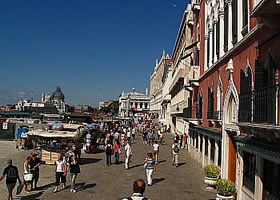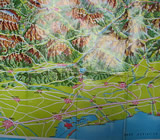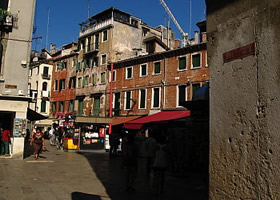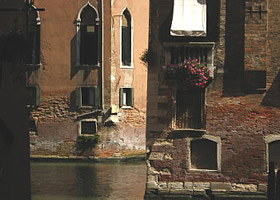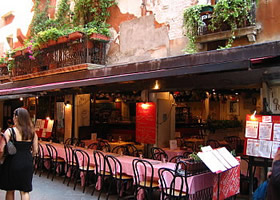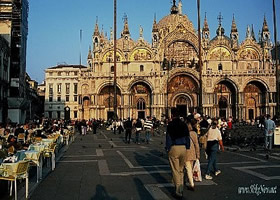
118 islets of Venice
Venice took many years to develop. The centre of first settlement was at today's Rialto area. A network of canals was planned and the earth the builders dug up, was used to strengthen the islands of the lagoon. The Grand Canal and the innumerable "rii" smaller canals of Venice links over 118 islets.
The famous Grand Canal or "Canalazzo" with its beatifull "Palazzi" and picturesque houses is the main thoroughfare. It flows from North West to South East (dividing Venice in two parts) into wider St. Marc's Canal. The Grand Canal crossed by three bridges (Railway bridge Rialto and the Academy) together with 45 small canals link all area.
Lagoon of Venice
The region is crossed by the Rivers Brenta, Piave, Livenza and Tagliamento and at the point at which they meet the sea form extensive lagoons. In the 5th. Century, the barbarians found that their easiest route from the North to Rome lay through these parts.
First Aquileia was destroyed by Attila in 453, and subsequently the whole of the territory of the Veneti was gradually burnt and sacked as the barbarians icreased their attacks on the capital of the Empire.
The inhabitants of the zone took refuge amongst the islands of the lagoon.
Venice - huts mounted on piles
At first, when the destructive wave of barbarians had passed through, the Veneti tended to return to their home towns, but when once again they were threatended, this time by the Lombards during the 7th. Century, the retreat to their refuges on the islands of the lagoon was final, and the communities of Chioggia, Malamocco, Jesolo, Eraclea, Carole and Grado were established to take the place of the unsafe mainland towns.
The refugees constructed their town flat-bottomed boats for moving about in the shallow waters of the lagoon, huts mounted on piles, and ground-floor rooms in stone which they brought with them from the mainland together with their livestock and their religious and civil traditions. These lagoon-dwellers found themselves under the sway of Byzantium and in order to survive, had to defend themselves from the attacks of barbarians from the mainland and of pirates from the sea.
Torcello meanwhile established itself as a commercial centre of some importance. The Franks, having first subjugated the Lombards, attempted also to defeat the lagoon communities by simultaneously mounting an attack from the mainland and also an encircling movement along the neck of the sea-ward side of the lagoon.
The Veneti, who by the 13th. Century had achieved so much in terms of social values, eight centuries previously were only just beginning to emerge onto the stage of history. They lived, fearful and forolorn in an ill-defined triangle of land the base of which was formed by the River Po and the sides by the Adriatic Sea and the Alps.They probably came from Ilyria in the second millenium BC and over-ran the Euganean hills, founded Vicenza, Treviso, Padua, Este, Belluno and other. Inthe first century BC these towns were Romanized and it was at this point that the local population was given the name Venetians which is Indo-European origin, and could mean "nobleman", but on the other hand its meaning on pre Indo-European would be "newcomers" or "foreigners".
